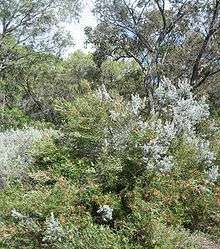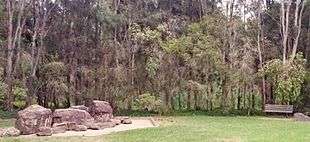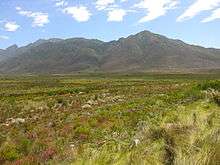Sclerophyll
Sclerophyll is a type of vegetation that has hard leaves, short internodes (the distance between leaves along the stem) and leaf orientation parallel or oblique to direct sunlight. The word comes from the Greek sklēros (hard) and phyllon (leaf).
Sclerophyllous plants occur in many parts of the world,[1] but are most typical in the chaparral biomes. They are prominent throughout western (Perth region), eastern (Sydney region) and southern (Adelaide region) parts of Australia,[2] in the Mediterranean forests, woodlands, and scrub biomes that cover the Mediterranean Basin, Californian chaparral and woodlands, Chilean Matorral, and the Cape Province of South Africa.
History
The term was coined by A.F.W. Schimper in 1898 (translated in 1903), originally as a synonym of xeromorph, but later was changed.[3]
Australian bush


Most areas of the Australian continent able to support woody plants are occupied by sclerophyll communities as forests, savannas, or heathlands. Common plants include the Proteaceae (grevilleas, banksias and hakeas), tea-trees, acacias, boronias, and eucalypts.
The most common sclerophyll communities in Australia are savannas dominated by grasses with an overstorey of eucalypts and acacias. Acacia (particularly mulga) shrublands also cover extensive areas. All the dominant overstorey acacia species and a majority of the understorey acacias have a scleromorphic adaptation in which the leaves have been reduced to phyllodes consisting entirely of the petiole.[4]
Many plants of the sclerophyllous woodlands and shrublands also produce leaves unpalatable to herbivores by the inclusion of toxic and indigestible compounds which assure survival of these long-lived leaves. This trait is particularly noticeable in the eucalypt and Melaleuca species which possess oil glands within their leaves that produce a pungent volatile oil that makes them unpalatable to most browsers.[5] These traits make the majority of woody plants in these woodlands largely unpalatable to domestic livestock.[6] It is therefore important from a grazing perspective that these woodlands support a more or less continuous layer of herbaceous ground cover dominated by grasses.
Sclerophyll forests cover a much smaller area of the continent, being restricted to relatively high rainfall locations. They have a eucalyptus overstory (10 to 30 metres) with the understory also being hard-leaved. Dry sclerophyll forests are the most common forest type on the continent, and although it may seem barren dry sclerophyll forest is highly diverse. For example, a study of sclerophyll vegetation in Seal Creek, Victoria, found 138 species.[7]
Even less extensive are wet sclerophyll forests. They have a taller eucalyptus overstory than dry sclerophyll forests, 30 metres or more (typically mountain ash, alpine ash, messmate stringybark, or manna gum), and a soft-leaved, fairly dense understory (tree ferns are common). They require ample rainfall — at least 1000mm (40 inches).
Evolution
Sclerophyllous plants are all part of a specific environment and are anything but newcomers. By the time of European settlement, sclerophyll forest accounted for the vast bulk of the forested areas.
Most of the wooded parts of present-day Australia have become sclerophyll dominated as a result of the extreme age of the continent combined with Aboriginal fire use. Deep weathering of the crust over many millions of years leached chemicals out of the rock, leaving Australian soils deficient in nutrients, particularly phosphorus. Such nutrient deficient soils support non-sclerophyllous plant communities elsewhere in the world and did so over most of Australia prior to European arrival. However such deficient soils cannot support the nutrient losses associated with frequent fires and are rapidly replaced with sclerophyllous species under traditional Aboriginal burning regimens. With the cessation of traditional burning non-sclerophyllous species have re-colonized sclerophyll habitat in many parts of Australia.
The presence of toxic compounds combined with a high carbon : nitrogen ratio make the leaves and branches of scleromorphic species long-lived in the litter, and can lead to a large build-up of litter in woodlands.[8][9] The toxic compounds of many species, notably Eucalyptus species, are volatile and flammable and the presence of large amounts of flammable litter, coupled with an herbaceous understorey, encourages fire.[10]
All the Australian sclerophyllous communities are liable to be burnt with varying frequencies and many of the woody plants of these woodlands have developed adaptations to survive and minimise the effects of fire.[11]
Sclerophyllous plants generally resist dry conditions well, making them successful in areas of seasonally variable rainfall. In Australia, however, they evolved in response to the low level of phosphorus in the soil — indeed, many native Australian plants cannot tolerate higher levels of phosphorus and will die if fertilised incorrectly. The leaves are hard due to lignin, which prevents wilting and allows plants to grow, even when there isn't enough phosphorus for substantial new cell growth.[12]
See also
- Mediterranean forests, woodlands, and scrub
- Chaparral
- California chaparral and woodlands
- Chilean Matorral
- Tropical and subtropical coniferous forest
- Fynbos
- Garrigue
- Kwongan
- Mallee Woodlands and Shrublands
- Maquis shrubland
- Matorral
References
- C. Michael Hogan. 2010. Leather Oak, Quercus durata. Encyclopedia of Earth. National Council for Science and Environment. Washington DC
- "Sydney Coastal Dry Sclerophyll Forests". NSW Environment & Heritage. Retrieved September 17, 2012.
- Bowman, D. M. J. S. (2000). The sclerophyll problem. In: Australian Rainforests. 1st ed. Cambridge: Cambridge University Press, 2000. pp. 48-67, .
- Simmons, M. 1982. Acacias of Australia. Thomas Nelson, Melbourne
- Florence, R. G. 1996. Ecology and silviculture of eucalypt forests. CSIRO Publishing, Collingwood.
- Mott, J. J., and J. C. Tothill. 1984. Tropical and subtropical woodlands. in G. N. Harrington and A. D. Wilson, editors. Management of Australia's Rangelands. CSIRO Publishing, Melbourne
- Parsons R. F.; Cameron D .G. (1974). "Maximum Plant Species Diversity in Terrestrial Communities". Biotropica. The Association for Tropical Biology and Conservation. 6 (3): 202. doi:10.2307/2989653. JSTOR 2989653.
- White, M. E. 1986. The Greening of Gondwana. Reed Books, Frenchs Forest, Australia.
- Flannery, T. 1994. The future eaters. Reed New Holland, Frenchs Forest, Australia.
- Burrows, W. H., J. O. Carter, J. C. Scanlan, and E. R. Anderson. 1990. Management of savannas for livestock production in north-east Australia: contrasts across the tree-grass continuum. Journal of Biogeography 17:503–512.
- Harrington, G. N., M. H. Friedel, K. C. Hodgkinson, and J. C. Noble. 1984. Vegetation ecology and management. in G. N. Harrington and A. D. Wilson, editors. Management of Australia's Rangelands. CSIRO Publishing, Melbourne.
- R. Major (2003). "Sclerophyll forests". Australian Museum. Retrieved February 14, 2005.
